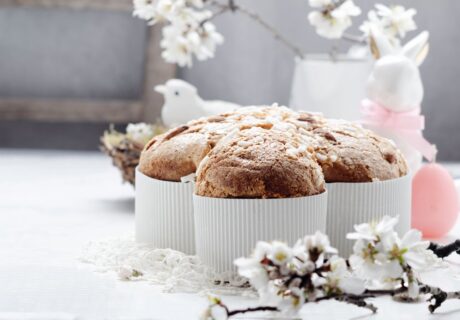Typical desserts of Tuscany
5 min · 29 May 2023

Do you have a sweet tooth? Then Tuscany is definitely the right destination for you. Traditional Tuscan cuisine offers a varied sampling of sweet specialities, often linked to the rural world, ancient customs and simple but no less tasty ingredients.
Below we present a selection of traditional Tuscan desserts, however, take something to eat because your mouth will surely water!
The castagnaccio
Castagnaccio is an autumn cake typical of the Apennine areas of Tuscany, where the culture and economy of the chestnut, whose flour is the main ingredient of the dough, were strong. In addition to chestnut flour, the preparation requires water, olive oil, salt, pine nuts, sultanas and a few other ingredients that vary from area to area. Moist and compact, it has a delicate and unmistakable taste. There is no certain information about its origins, but according to the Commentario delle più notabili et mostruose cose d’Italia e altri luoghi (1553), the inventor seems to have been a certain Pilade da Lucca, about whom not much is known. It goes well with ricotta or chestnut honey, vino novello or sweet wines such as vin santo.
The buccellato
Buccellato is the typical cake of Lucca (included in the list of traditional agri-food products). Thus goes an old popular saying from Lucca: ‘He who comes to Lucca and does not eat buccellato, it is as if he had never been there’. Not to be confused with the much richer and more articulate Sicilian buccellato, it is a type of sweet bread flavoured with aniseed, rich in sultanas and aniseed seeds. It derives its name from the Latin word ‘buccella’, meaning morsel: for the ancient Romans, buccellatum was a round bread made from a ring of rolls. The modern buccellato originally had the shape of a doughnut, but today it can also be found in a straight shape. It is eaten with a good liqueur wine, cream and coffee, ricotta and rum.
The Florentine-style schiacciata
The Florentine-style schiacciata is a typical cake of the carnival period (but perfect, actually, for any occasion) and should not be confused with the schiacciata salata, a kind of low bread that is the protagonist of snacks and snacks. It is a soft and delicate cake made with white flour, eggs, baking powder and orange peel. It is recognisable at first sight because tradition has it decorated with a Florentine lily. It was already mentioned in the 19th century by the gastronome Pellegrino Artusi under the name ‘stiacciata unta’. In addition to the classic one, versions filled with whipped cream, custard or gianduia have also appeared recently.
The zuccotto
Another typical Florentine cake, but renowned and appreciated throughout Tuscany, is the zuccotto, a dome of soft sponge cake filled with a delicious cream made of fresh ricotta, sugar, chocolate drops and whipped cream. It is a dessert that has its roots in the history of Florence. It is said to have been invented by Bernardo Buontalenti, the same man to whom we also owe the invention of ice cream, in honour of Queen Catherine de’ Medici and was originally known as ‘Catherine’s Helmet’ because it was prepared using a small helmet, in use at the time by the infantry of the Florentine army, as a mould.
The ricciarelli
Ricciarelli are a typical Sienese sweet made from a baked dough of carefully selected sweet and bitter almonds, sugar and egg white. According to tradition, they are shaped like a grain of rice. It is a Christmas cake but is sold all year round in bakeries and pastry shops. Its origins date back to the Middle Ages, when the Sienese imported marzipan from the East. They were once known as ‘marzapanetti alla senese’ or ‘morzelletti’ and it was only in the 19th century that the name ‘ricciarelli’ appeared. They go well with tea, coffee or sweet Tuscan wines.
The cantucci
We conclude this roundup of typical Tuscan sweets with cantucci (or cantuccini), the ultra-famous dry almond biscuits, made by slicing a loaf of dough while still warm. They boast a very ancient history. There is mention of the name ‘cantuccio’ as far back as the 17th century in the Crusca Academy Dictionary, which defined it as a ‘sliced biscuit, made of flour, with sugar and egg white’. Today, there are several variations: with chocolate, candied orange peel, dried figs, hazelnuts and more. They are excellent on their own or accompanied by a glass of vin santo, strictly Tuscan.
Photo Florentine-style schiacciata © FirenzeToday








